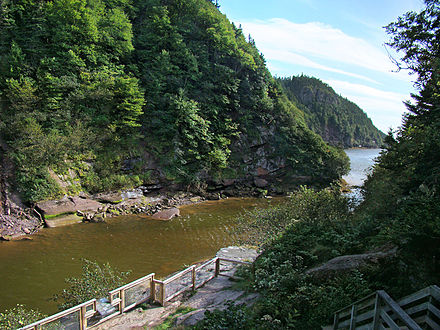Bay of Fundy - bay on the Atlantic coast of Canada noted for high tides
The Bay of Fundy, between the southern coast of New Brunswick and the province of Nova Scotia, is famous for the highest tides in the world.
This region of New Brunswick is notable for its seafood and historic coastal towns.
Cities
- Saint John — the province's second-largest city, and home of the provincial museum
- St. Stephen — "Canada's Chocolate Town"
- St. Andrews — an historic seaside resort town
- St. George — a town on the Magaguadavic River
- St. Martins — has twin covered bridges
- Sussex — the "Dairy Centre of the Maritimes"
- Alma — headquarters of the Fundy National Park, and a fishing town for lobster and scallops
Other destinations

- Deer Island — the Old Sow, the largest tidal whirlpool in the western hemisphere, can be viewed from Deer Island Point Park
- Campobello Island — a popular summer colony for wealthy Canadians and Americans, including Franklin D. Roosevelt spent his summers at a family estate on Campobello
- Grand Manan Island — a beautiful island of small fishing communities
- Machias Seal Island — a Canadian Wildlife Service sanctuary and nesting ground for thousands of seabirds, and a lighthouse
- Fundy National Park — a rugged coastline, the highest tides in the world and more than 25 waterfalls
Understand


The tidal range is famous as the Bay of Fundy acts as a funnel, directing massive amounts of tidal energy to one point; this generates the region's famously large high tides. The tidal range in the Bay of Fundy is about 13 metres (43 ft). (The average tidal range worldwide is about 1 metre.) In one 12-hour tidal cycle, about 100 billion tonnes of water flows in and out of the bay, which is twice as much as the combined flow of all the rivers of the world over the same period.
Most of the rivers have a tidal bore, a wave front of the incoming tide that "bores" its way up a river against its normal flow. Notable ones include those on the Maccan, St. Croix, and Kennetcook rivers. The Petitcodiac River has one of the world's largest tidal bores, up to 2 m high. In 2013 surfers rode it a record-breaking 29 km.
Other phenomena include the Reversing Falls near the mouth of the Saint John River, a rip tide at Cape Enrage, and the Old Sow whirlpool at Passamaquoddy Bay.
The name is likely a corruption of the French word fendu, meaning "split".
History
The Mi'kmaq fished in the Bay of Fundy and lived in communities around the bay for centuries before the first Europeans arrived. According to Mi'kmaq legend, the tide was created when Glooscap wanted to take a bath.
The first European to visit the bay may have been Portuguese explorer João Álvares Fagundes in about 1520. The first European settlement was French, founded at Île-Saint-Croix, and then Port Royal, founded in 1605. Champlain named it Baie Française (French Bay). About 75 years later, Acadians spread out along the bay. There was much military action and many attacks on the settlements around the bay, first as the French and British fought for control of the area, leading to the Expulsion of the Acadians, and later by Americans during the American Revolution and the War of 1812.
In the 1800s, shipbuilders flourished. Fundy ports produced the fastest ship in the world, Marco Polo; the largest wooden ship ever built in Canada, William D. Lawrence; and the first female sea captain in the western world, Molly Kool. The mystery ship Mary Celeste was also built there.
Talk
While New Brunswick is officially a bilingual province (due to the historic presence of both United Empire Loyalists and Acadians), the southern portion of the province is disproportionately English-speaking.
Get in
Most visitors arrive by driving the Trans-Canada Highway (which leads from Edmundston through Fredericton and Moncton), perhaps stopping to see attractions like the World's Largest Axe, the World's Longest Covered Bridge, the sunrise over the Saint John river valley and Magnetic Hill on the outskirts of Moncton.
Maritime Bus provides intercity bus service to Saint John (although it does not reach smaller towns in the region) and an automobile/passenger ferry from Saint John to Digby.
- Saint John Airport (IATA: YSJ), 45.316111°, -65.89°, fly@saintjohnairport.com. Served several times daily by flights from Montreal, Toronto, Ottawa, and Halifax. (Don't mix up the destination with St. John's.)
Get around
Most get around by car.
As the region is relatively hilly, bicycle lanes are still limited, but one can bicycle around the region. The flat upper region of the bay is especially suited to this, and in places you can follow the Trans-Canada Trail.
The bay is traversed by ferries:
- Saint John to Digby, operated by Bay Ferries.
- Grand Manan to Blacks Harbour and White Head Island, to Grand Manan, operated by Coastal Transport.
- The Letete to Deer Island Ferry, operated by the New Brunswick Department of Transportation.
- Campobello Island, to Deer Island and Eastport, Maine, to Deer Island. Operated by East Coast Ferries Limited.
- Brier Island) to Long Island and Long Island to peninsular Nova Scotia, operated by Nova Scotia Department of Transportation and Public Works.
See
The area is rich in natural beauty as well as cultural and historical highlights.
See the Bay at both high and low tide: check the times of the tides.
The New Brunswick Museum in Saint John has a wide array of local historic information and artefacts, artwork, scientific exhibits and displays, and a Discovery Centre with many interactive and educational activities. The museum has a to-scale plaster of a mastodon skeleton and skeletons of whales.
The City Market in Saint John is the oldest continuing farmer's market in Canada. Local businesses, craft workers, artists, farmers, bakers and grocers sell a wide array of unique foods and crafts, native to New Brunswick or around the world. The building is a historic site with amazing period architecture.
The Kingsbrae Garden in Saint Andrews is a gorgeous 27-acre horticultural garden. It has over 50,000 perennials on many themed gardens, great Canadian sculpture competition, alpacas, peacocks, Dutch windmill, and cedar maze.
Do
 In Fundy National Park, you can explore the ocean floor at low tide, kayak, and hike.
In Fundy National Park, you can explore the ocean floor at low tide, kayak, and hike.
The Chocolate Fest is held in the first week in August, celebrating the products of the local chocolate factory.
Take a Sea Watch Tour to Machias Seal Island from Grand Manan.
Eat
The area is known for its seafood, especially lobster, but you will also find other regional foods. The picturesque village of Alma on the east side of Fundy National Park, is a vibrant active lobster harbour, and boasts three different lobster shops. You can also dine at the hotel in town, and eat seafood while overlooking the harbour. Digby, on the Nova Scotia side of the bay, is known as the scallop capital of the world. Fiddlehead greens are a delicacy in the spring, and in late winter maple foods are common especially in the upper half of the bay.
Stay safe
Stay well away from the water as the tide is coming in, as the extreme tides in the basin mean that water levels could easily rise a few feet in a matter of minutes. A tremendous amount of tidal power is funnelled into a relatively-small area, potentially dangerous for the unwary.
Go next
Bay of Fundy
bayoffundytourism.comDate Time:Please wait...Timezone:America/MonctonCoordinates:45.00, -65.75
Nova Scotia
Primary administrative division